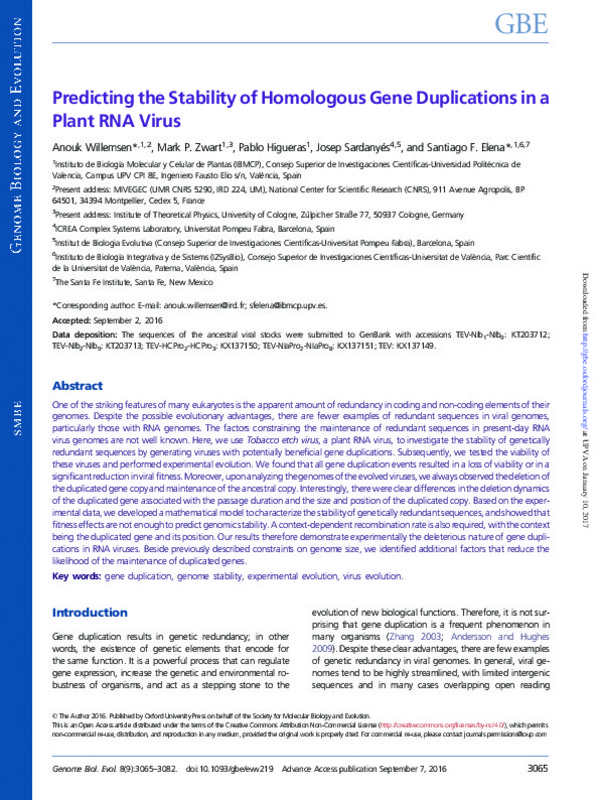JavaScript is disabled for your browser. Some features of this site may not work without it.
Buscar en RiuNet
Listar
Mi cuenta
Estadísticas
Ayuda RiuNet
Admin. UPV
Predicting the Stability of Homologous Gene Duplications in a Plant RNA Virus
Mostrar el registro sencillo del ítem
Ficheros en el ítem
| dc.contributor.author | Willemsen, Anouk
|
es_ES |
| dc.contributor.author | Zwart, Mark Peter
|
es_ES |
| dc.contributor.author | Higueras, Pablo
|
es_ES |
| dc.contributor.author | Sardanyes Cayuela, Jose
|
es_ES |
| dc.contributor.author | Elena Fito, Santiago Fco
|
es_ES |
| dc.date.accessioned | 2017-05-08T11:57:30Z | |
| dc.date.available | 2017-05-08T11:57:30Z | |
| dc.date.issued | 2016-09 | |
| dc.identifier.issn | 1759-6653 | |
| dc.identifier.uri | http://hdl.handle.net/10251/80738 | |
| dc.description.abstract | One of the striking features of many eukaryotes is the apparent amount of redundancy in coding and non-coding elements of their genomes. Despite the possible evolutionary advantages, there are fewer examples of redundant sequences in viral genomes, particularly those with RNA genomes. The factors constraining the maintenance of redundant sequences in present-day RNA virus genomes are not well known. Here, we use Tobacco etch virus, a plant RNA virus, to investigate the stability of genetically redundant sequences by generating viruses with potentially beneficial gene duplications. Subsequently, we tested the viability of these viruses and performed experimental evolution. We found that all gene duplication events resulted in a loss of viability or in a significant reduction in viralfitness. Moreover,uponanalyzing thegenomesof theevolved viruses,wealways observedthedeletionof the duplicated gene copy andmaintenance of the ancestral copy. Interestingly, there were clear differences in the deletion dynamics of the duplicated gene associated with the passage duration and the size and position of the duplicated copy. Based on the experimental data,wedeveloped a mathematical model to characterize the stability of genetically redundant sequences, and showed that fitness effects are not enough to predict genomic stability.Acontext-dependent recombination rate is also required, with the context being the duplicated gene and its position. Our results therefore demonstrate experimentally the deleterious nature of gene duplications in RNA viruses. Beside previously described constraints on genome size, we identified additional factors that reduce the likelihood of the maintenance of duplicated genes. | es_ES |
| dc.description.sponsorship | We thank Francisca de la Iglesia and Paula Agudo for excellent technical assistance. This work was supported by the John Templeton Foundation [grant number 22371 to S.F.E.]; the European Commission 7th Framework Program EvoEvo Project [grant number ICT-610427 to S.F.E.]; the Spanish Ministerio de Economia y Competitividad (MINECO) [grant numbers BFU2012-30805 and BFU2015-65037-P to S.F.E.]; the Botin Foundation from Banco Santander through its Santander Universities Global Division [J.S.]; the Secretaria d'Universitats i Recerca del Departament d'Economia i Coneixement de la Generalitat de Catalunya [J.S.]; and the European Molecular Biology Organization [grant number ASTF 625-2015 to A.W]. The opinions expressed in this publication are those of the authors and do not necessarily reflect the views of the John Templeton Foundation. The funders had no role in study design, data collection and analysis, decision to publish, or preparation of the manuscript. | en_EN |
| dc.language | Inglés | es_ES |
| dc.publisher | Oxford University Press (OUP) | es_ES |
| dc.relation.ispartof | Genome Biology and Evolution | es_ES |
| dc.rights | Reconocimiento - No comercial (by-nc) | es_ES |
| dc.subject | Gene duplication | es_ES |
| dc.subject | Genome stability | es_ES |
| dc.subject | Experimental evolution | es_ES |
| dc.subject | Virus evolution | es_ES |
| dc.title | Predicting the Stability of Homologous Gene Duplications in a Plant RNA Virus | es_ES |
| dc.type | Artículo | es_ES |
| dc.identifier.doi | 10.1093/gbe/evw219 | |
| dc.relation.projectID | info:eu-repo/grantAgreement/JTF//22371/ | es_ES |
| dc.relation.projectID | info:eu-repo/grantAgreement/EC/FP7/610427/EU/Evolution of Evolution/ | en_EN |
| dc.relation.projectID | info:eu-repo/grantAgreement/EMBO//ASTF 625-2015/EU/ | es_ES |
| dc.relation.projectID | info:eu-repo/grantAgreement/MINECO//BFU2012-30805/ES/EVOLUTIONARY SYSTEMS VIROLOGY: EPISTASIS AND THE RUGGEDNESS OF ADAPTIVE LANDSCAPES, MUTATIONS IN REGULATORY SEQUENCES, AND THE HOST DETERMINANTS OF VIRAL FITNESS/ | es_ES |
| dc.relation.projectID | info:eu-repo/grantAgreement/MINECO//BFU2015-65037-P/ES/EVOLUCION DE VIRUS EN HUESPEDES CON SUSCEPTIBILIDAD VARIABLE: CONSECUENCIAS EN EFICACIA Y VIRULENCIA DE CAMBIOS EN LAS REDES INTERACTOMICAS DE PROTEINAS VIRUS-HUESPED/ | es_ES |
| dc.rights.accessRights | Abierto | es_ES |
| dc.contributor.affiliation | Universitat Politècnica de València. Instituto Universitario Mixto de Biología Molecular y Celular de Plantas - Institut Universitari Mixt de Biologia Molecular i Cel·lular de Plantes | es_ES |
| dc.description.bibliographicCitation | Willemsen, A.; Zwart, MP.; Higueras, P.; Sardanyes Cayuela, J.; Elena Fito, SF. (2016). Predicting the Stability of Homologous Gene Duplications in a Plant RNA Virus. Genome Biology and Evolution. 8(9):3065-3082. https://doi.org/10.1093/gbe/evw219 | es_ES |
| dc.description.accrualMethod | S | es_ES |
| dc.relation.publisherversion | http://dx.doi.org/10.1093/gbe/evw219 | es_ES |
| dc.description.upvformatpinicio | 3065 | es_ES |
| dc.description.upvformatpfin | 3082 | es_ES |
| dc.type.version | info:eu-repo/semantics/publishedVersion | es_ES |
| dc.description.volume | 8 | es_ES |
| dc.description.issue | 9 | es_ES |
| dc.relation.senia | 323459 | es_ES |
| dc.identifier.pmid | 27604880 | en_EN |
| dc.identifier.pmcid | PMC5633665 | en_EN |
| dc.contributor.funder | European Molecular Biology Organization | es_ES |
| dc.contributor.funder | John Templeton Foundation | es_ES |
| dc.contributor.funder | Generalitat de Catalunya | es_ES |
| dc.contributor.funder | Fundación Botín | es_ES |








